--- Husband, Father, Labourer, Soldier, POW, Hero ---
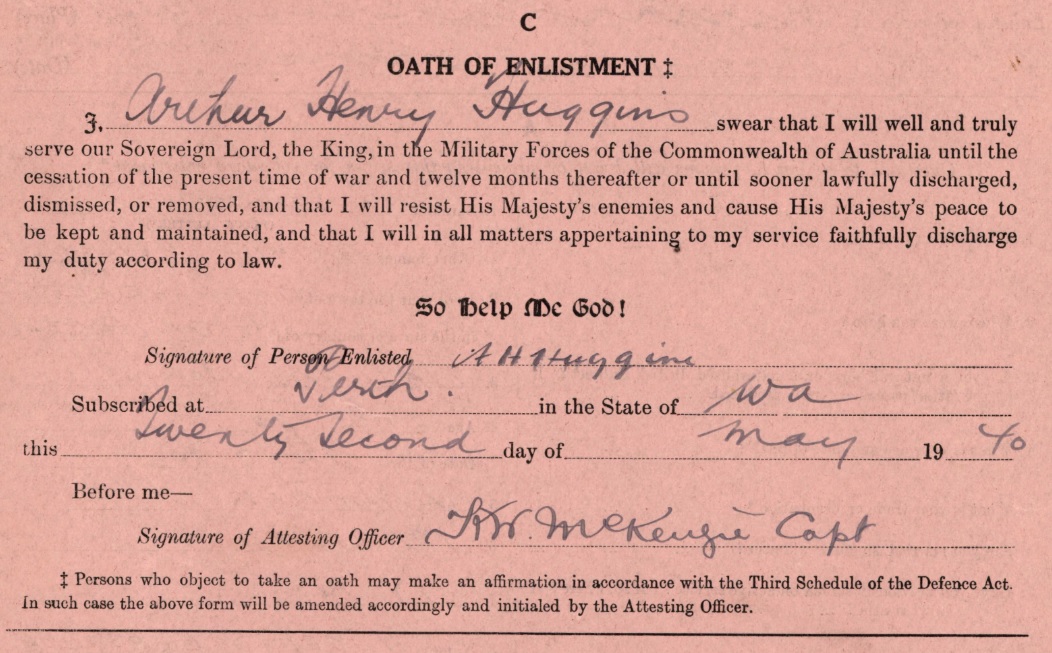
Oath of Enlistment by Arthur Henry HUGGINS from his WWII enlistment papers.
Courtesy of the National Archives of Australia.
Cover image: PH00479-02 Identity Photograph of Arthur Henry HUGGINS, Service Number WX3184. Courtesy of the National Archives of Australia.
Arthur Henry HUGGINS (1910-1987)
by guest historian Fred Rutter, and
Rosemary Ritorto,
Local History Coordinator
For the Victoria Park Dictionary of Biography
October 2025.
Birth and Early Life
Arthur Henry was born in Jarrahdale, Western Australia on the 24th of July 1910 to Edward and Florence Louisa (nee Dixon) Huggins. He was one of seven children born to the couple, but three sadly did not survive infancy. Cricket and fishing were favourite past times of Arthur and his younger brother Albert.
In 1917 the Huggins family were living in East Perth and by 1925 the family called Victoria Park home. Like their father Edward, both brothers, Arthur and Albert, also worked as labourers, most likely in the timber and forestry industries.
Marriage and Life in Victoria Park
On the 17th of March 1935, Arthur Henry Huggins married his sweetheart, Gertrude NIELD in a service at the Church of the Transfiguration, Victoria Park. The church was the wooden one built in 1897 and moved from Harvey Street to Leonard Street in the early 1930s. In the same year as their marriage, the present day St Peter’s Anglican Church opened. Arthur and Gertrude would have been among the last couples to be married in the old weatherboard church, which after the new church opened, served as the parish hall for many years.
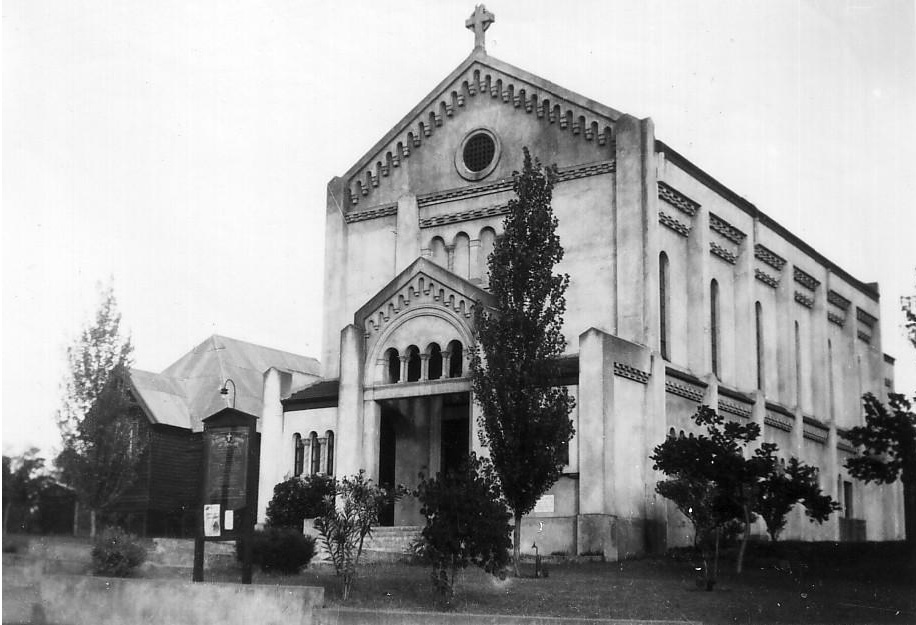
St Peter’s Anglican Church, 11 Leonard Street, Victoria Park, 1947. Photograph by E. W. Doncaster. The former Church of the Transfiguration, minus bell town, can be seen at left. It was by this time being used as the parish hall.
Courtesy of the Anglican Church Archives
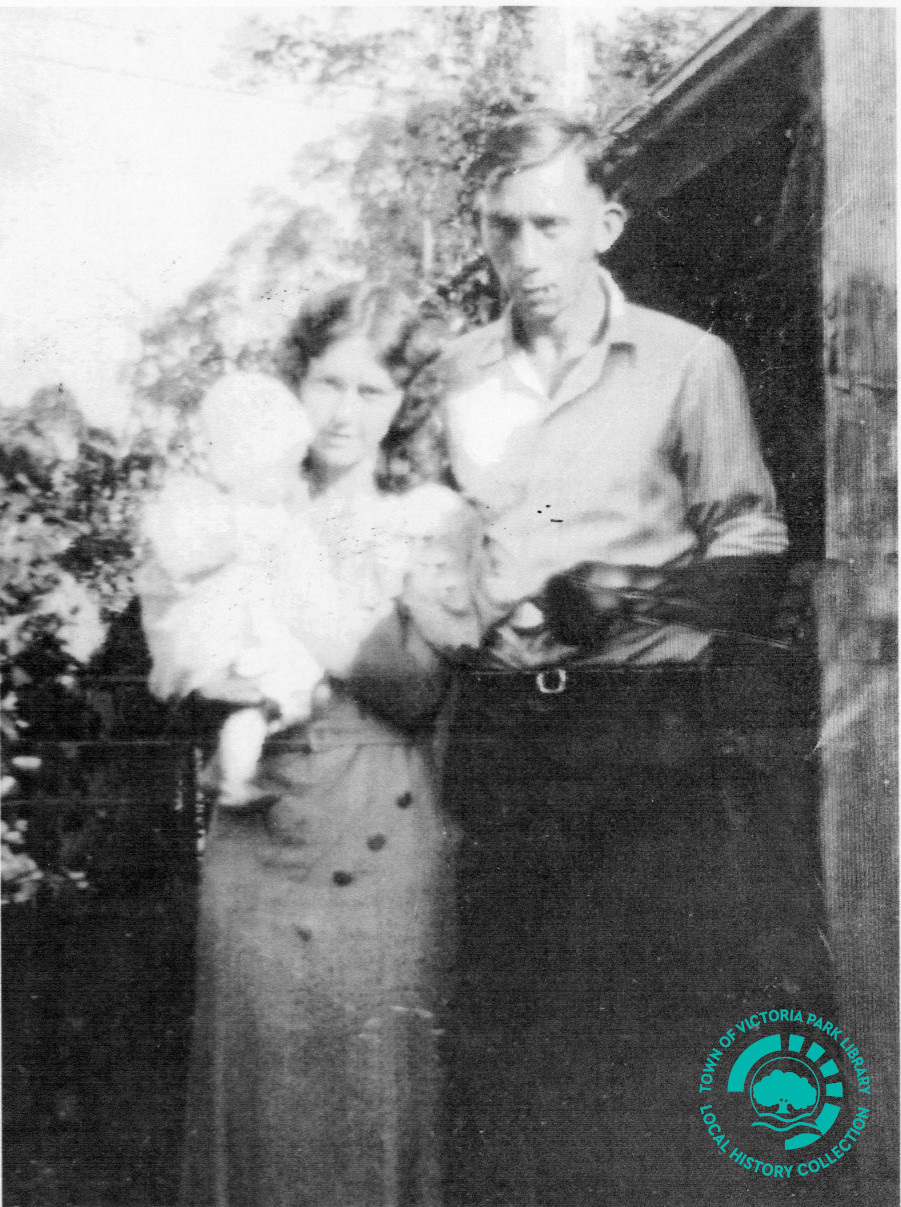
PH00479-06 Arthur and Gertrude (nee Nield) Huggins and baby Margaret, c1934-5. Courtesy of the Huggins Family.
Arthur and Gertrude had three children prior to 1940; their names were Margaret, Shirley and Edward Phillip. In a family portrait, taken at some time prior to Arthur’s embarkation, little Shirley and Edward are looking curiously at the photographer, whilst the eldest little Huggins, Margaret, proudly smiles, as she embraces each of her parent’s. No doubt there were mixed emotions being experienced by both Arthur and Gertrude, but the shy smile on Gertrude’s lips and the twinkle in Arthur’s eyes denotes a love for the family that they had created together. A bond that would no doubt help pull Arthur through many a hard time ahead.
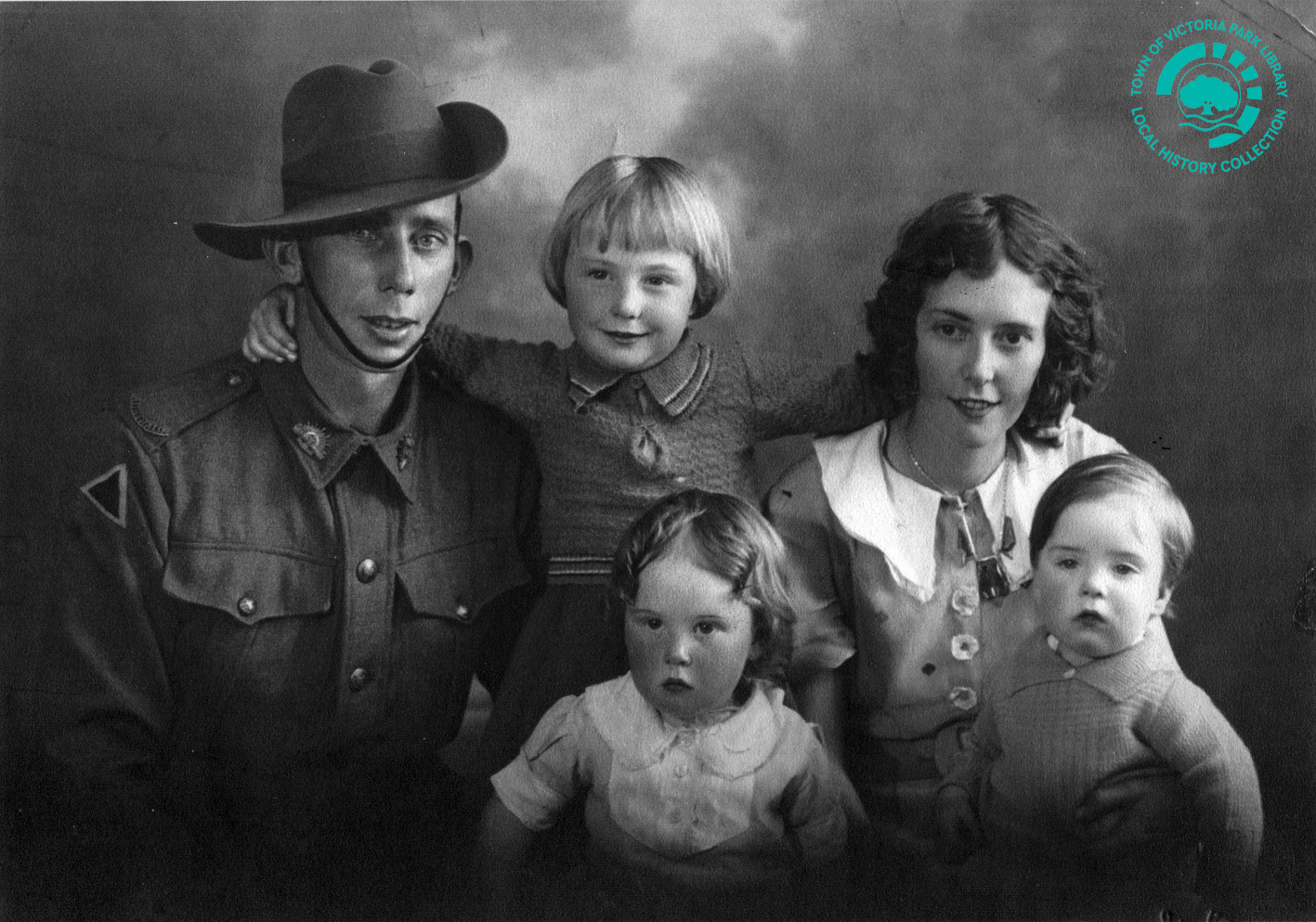
PH00479-01 Family portrait of Arthur and Gertrude Huggins with Margaret, Shirley and Ted, circa May 1940. Courtesy of the Huggins Family.
Enlistment
During WWII England called upon the Commonwealth countries for assistance.
On the 3rd of September 1939 Prime Minister Robert Menzies addressed the Australian nation with the following:
"Fellow Australians, it is my melancholy duty to inform you officially, that in consequence of a persistence by Germany in her invasion of Poland, Great Britain has declared war upon her and that as a result, Australia is also at war.”
Australia answered with almost a million men and women. These Aussies did not question what would be asked of them. Their country called and they answered. Each and everyone of them wrote a blank cheque to their country up to and including the value of their lives. Many paid the ultimate price, and many who returned did not speak of what they endured.
Arthur Henry Huggins was one of the Aussies who answered that call. Enlisting on the 22 May 1940, Arthur became Army Number WX 3184. He was 29 years old.
PH00479-03 and PH00479-02 Identity Photographs of Arthur Henry HUGGINS, Service Number WX3184. Courtesy of the National Archives of Australia (B883, WX3184)
Between the 27th of February 1940 and the 22nd of May of that same year Arthur was treated for a hernia, found fit, and assigned to the 2/7 Field Ambulance, 7th Division A.I.F.
His ‘Service and Casualty Form’ further notes he was ‘taken on strength’ in Northam on the 10th of June of that year.
From the 23rd to the 28th of June he was at the CDS Northam Evac Hospital suffering from influenza.
Arthur was informed that embarkation was imminent and granted leave from the 10th to the 16th of August 1940 to visit family. No doubt there was much jubilation amongst their three children, when Arthur came home to Gertrude and the family at 31 Kent Street, Victoria Park. Just six days of leave to make sure his family knew how much he loved them and they him.
War Service
On the 22nd of September 1940, Arthur Huggins embarked for the war on a ship in the Australian troop convoy designated ‘US 5’, departing Fremantle with the Dutch liners Christiaan Huygens, Indrapoera, Nieuw Holland, and Slamat. 4,262 troops were carried in this convoy. The convoy was escorted by heavy cruiser HMAS Australia until the 2nd of October. The convoy departed Colombo on the 1st of October.
The heavy cruiser Shropshire relieved the Australian cruiser on the 2nd of October and remained with the convoy until the 8th of October, when the convoy was joined by the light cruiser Hobart, anti-aircraft cruiser Carlisle, destroyers Kandhar and Voyager, and sloop Flamingo.
The convoy ‘US 5’ arrived at Suez on the 12th of October.
Arthur was detached to the 2/1 Infantry Battalion, 2d Ambulance from the 20th to the 29th of November. The 2/1 were training in Palestine at this time. He rejoined his unit the 2/7 Field Ambulance on the 29th of November. These detachments (or temporary reassignments) became a normal part of army life.
Arthur was then detached to the 2/2 Field Ambulance the 2/2 Infantry which advanced from Egypt in to Libya. They were involved in the capture of Bardia in early January in which 130 Australians died and 326 were wounded. The enemy casualties were in the thousands.
They then moved on to the bloody fighting for Tobruk towards the end of January 1941. They faced dust storms, severe cold and daily bombings.
The 2/2 remained as part of the Tobruk garrison but Arthur rejoined his unit in Egypt on the 9th of February 1941. They then took up defensive positions at Marsa Brega.
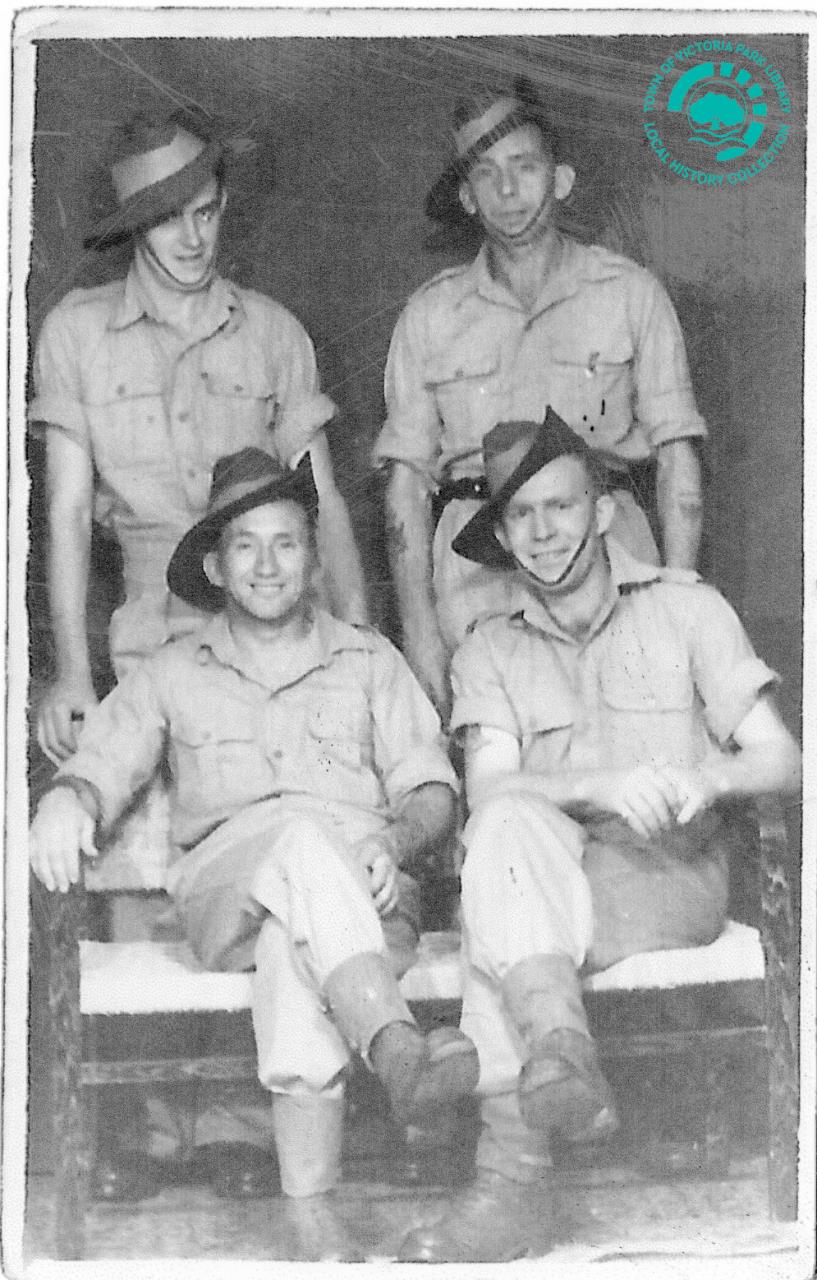
PH00479-05 Arthur Henry Huggins (top right) and three unknown mates.
Courtesy of the Huggins Family.
The Battle for and Evacuation of Crete
“In early April 1941, the 2/7th, with the rest of the 6th Division, deployed to Greece to resist the anticipated German invasion. For the 2/7th, the Greek campaign was essentially one long withdrawal through a series of rearguard positions, beginning on 16 April. The majority of the 2/6th were evacuated from Kalamata aboard the Costa Rica on the night of 26 April. On the afternoon of 27 April, however the Costa Rica was crippled by German aircraft. The men of the 2/7th were rescued by a pair of British destroyers and landed on Crete.
On Crete, the 2/7th were initially deployed to defend the coastline around Georgioupolis but, after the German airborne landings on 20 May, were soon moved up to join the fighting around Canea. On 27 May the battalion took part in a wild bayonet charge at 42nd Street that temporarily rebuffed the German advance. The 2/7th subsequently played a critical rearguard role as the Allied forces retreated across the island to Sphakia. As a result, the battalion was left behind and taken prisoner after the withdrawal of the last evacuation vessels from Sphakia on 1 June.” (1)
The duties of an ambulance unit member must have been horrendous in both North Africa and Crete.
Prisoner of War
Arthur was transferred to the ‘X’ LIST which included those confirmed prisoners of war, personnel officially declared missing and other sundry statuses. In Arthur’s case he was officially declared missing in action.
Arthur’s wife would have received a telegram as follows:
LANCE CORPORAL HUGGINS MISSING I REGRET TO INFORM YOU THAT WX3184 L/CPL ARTHUR HENRY HUGGINS HAS BEEN REPORTED MISSING THE MINISTER FOR THE ARMY AND MILITARY BOARD EXTEND SINCERE SYMPATHY
MINISTER FOR THE ARMY
On the 20th of June The Sydney Morning Herald published; “Australian Casualties for four states, 1,330 Reported Missing”. Arthur was on that list (2).
Yet all the while Arthur had been taken prisoner of war on 1 June 1941.
The Germans used the phrase ‘Für dich ist der Krieg Vorbei’ – ‘For you the war is over’
“Whether a soldier was captured in Greece or Crete, the next few weeks had a grim similarity. On foot, by road, rail or sea, he would eventually be taken to a temporary camp in Salonika. From there, he would be packed into a railway wagon designed for carrying cattle, with fifty other prisoners of war. There followed days of hunger, thirst and lack of sleep as the train made its slow way up through Yugoslavia to southern Austria and the final destination of Stalag(s) throughout the German occupied territories” (3)
Arthur and his unit were held for 21 days on Crete before being sent to Salonika, Greece and kept in two compounds there for 33 days. They were then sent to Stalag VIIA at Moosburg, Germany.
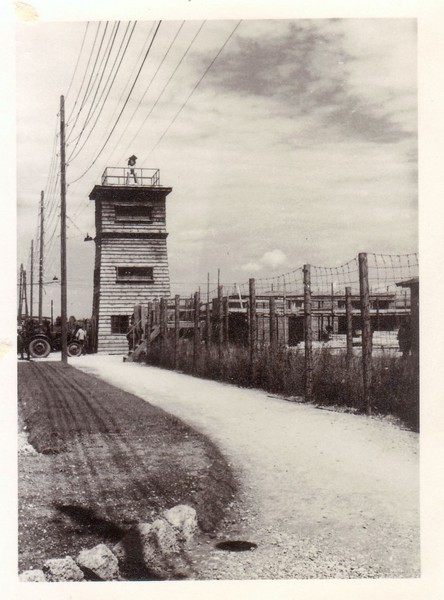
Main watchtower and entrance of the prisoner of war camp known as Stalag VIIA in Moosburg, Germany.
Courtesy of Moosburg Online (album-0005)
The Daily News, Tue 30 Sep 1941, Page 16
Captured in Crete
Lance-Corporal Arthur Huggins, who was captured in Crete, is now interned in a German prison camp.
His wife, who lives at 9 Manchester Street, Victoria Park, has received a postcard from him and word from the military informing her of this.
Lance-Corporal Huggins is 32, was attached to the Field Ambulance.
He left Australia about 12 months ago and a few months later his younger brother, Signaller Albert Huggins left here.
His brother is now in Palestine. (4)
Arthur was Mentioned in Despatches (MID) 30 December 1941 for actions on the 30th of December 1941. Being mentioned in despatches is just short of an official award for courage and valour, unfortunately no further details have been discovered as to the reason for this MID.
Arthur was moved to Stalag XIIIC at Hammelburg for a short time and subsequently was moved to Stalag VIIIB in Lamsdorf, Poland. This was renamed Stalag 334 and half of the POWs were then moved to Stalag VIIIC at Sagan, Poland.
Arthur’s official POW statement taken, after he was released, stated that he found:
- The accommodation fair,
- The quantity and quality of the rations fair,
- The clothing was supplied by the British Red Cross,
- The bathing and sanitary conditions no good,
- The recreational facilities no good.
Whilst a POW, Arthur was put to work gardening vegetables for 48 hours per week. For this work he was paid 1 Reich mark per day. He noted in his statement that he was not drawing this by himself.
He also noted that he received Red Cross packages and mail regularly.
Food parcels usually contained the following: Tea, cocoa, sugar, chocolate, oatmeal, biscuits, sardines, dried fruit, condensed milk, jam, corned beef, margarine, cigarettes/tobacco, and soap.
On the 3rd of November 1943, Arthur was part of a prisoner exchange and as such was transited to Barcelona where he boarded a troopship for Egypt.
“THE REPATRIATION OF WOUNDED PRISONERS.
Mixed Medical Commissions had been formed in 1939 to assess the condition of wounded British and German prisoners of war and compile lists of those recommended for repatriation. By the end of 1940 their findings were complete and negotiations began early in 1941 to arrange the exchange, It took until September of 1941 to agree on the two ports to be used; Newhaven in the UK and Dieppe in France and two British hospital ships were to be used to transport the 150 sick and wounded German POWs and 1,500 sick and wounded British. The exchange ground to a halt however, when the Germans insisted that, due to the disparity in numbers, German civilians should be sent back as well as the German wounded. This was contrary to Article 68 of the Prisoners of War Convention, which specifically requires that repatriation should take place ‘without regard to rank or numbers’.
In August 1943 an agreement was finally made proposing an exchange through Gothenburg, Smyrna and Oran. These three operations involved the exchanged of Germans held in the United Kingdom and Canada against British prisoners belonging to the UK, Canada and South Africa at Gothenburg; of Germans held in the Middle East and Egypt against British destined for India, Australia and New Zealand at Smyrna (later changed to Barcelona) and of Germans held at Tunisia at Oran.
The British supplied The Empress of Russia and the Hospital Ship Atlantis and the Swedish the vessel Drottningholm for the exchange at Gothenburg and from the Middle East the Cuba and the Tairea carried German prisoners of war to Barcelona and returned to Alexandria with British prisoners of war. To transport British prisoners to Gothenburg the German authorities used the Sassnitz-Trelleborg Ferry as well as the ships Meteor and Ruegen which sailed form the port of Swinemunde. For the exchange at Oran the Germans used the former Italian hospital ship Gradisca, which joined the two ex-French ships Sinaia and Djenne at Marseilles.
The exchanges at Gothenburg and Oran on 20th October 1943 saw over 4,000 British and nearly 5,000 German prisoners of war repatriated, while a further 1,000 British and 1,000 German prisoners were repatriated through Barcelona on 27th October. Unfortunately, some 150 British prisoners of war who had been passed for repatriation through Gothenburg did not get away due to an administrative breakdown, but they were sent home on the next exchange.” (5)
Arthur’s group arrived at Alexandria Egypt on the 3rd of November 1943.
The Sunday Times reported in an article on Sunday, 28 November 1943:
“OUT OF GERMANY
Mrs G. Huggins, of Carlisle, has been notified that her husband Corporal Arthur Henry Huggins, is one of the protected personnel who are being repatriated from Germany.
Corporal Huggins left Australia in September, 1940, was taken prisoner on June 1, 1941, in Crete.
Prior to that he was mentioned in despatches for distinguished services in Greece, but his family have to wait until his return home to hear the story of his exploits. He was a stretcher-bearer in the Army Medical Service.
A happy coincidence is that Corporal Huggins’ brother will be home on leave this Christmas after four years’ service in North Africa and New Guinea” (6).
On the 19 of January 1944 Arthur landed at Fremantle.
A short while after his return, The Daily News published an interesting story about how Arthur came to be included in the prisoner exchange:
“P.O.W. GAVE PLACE TO HIS FRIEND
Offered a ‘ticket home’ from a German prison camp under the exchange system, a young West Australian gave it to a comrade.
Self-sacrificing soldier was Pte. Charles J. Drake, who was captured in Crete. A single man, Drake considered he should yield his place to a married man. He offered it to L/Cprl Arthur Henry Huggins of 2 Venus Street, Carlisle. Huggins did not want to take it but Drake said that if he did not he would give it to somebody else, so Huggins then accepted.
Men served with different units,. In the same brigade, and were both captured in Crete. In the prison camp they became close friends and spent much time talking about their homes and friends in Western Australia.
L/Cpl Huggins was a member of a Field Ambulance and left Australia early in 1940. After serving through the first Western Desert campaign he went with his unit to Greece, and from there was evacuated to Crete. For his work on the island he was mentioned in despatches.
Drake was a motor-cycle orderly in the signal platoon of a West Australian infantry battalion. In the Libyan campaign his work was particularly good.
He also went with his battalion to Greece and thence to Crete, and it was when the bulk of the unit was left behind after the evacuation that he became a prisoner-of-war.
Before leaving the prison camp Huggins left instructions that any parcels arriving for him were to be given to Drake.
A son of Mr Edward Huggins, Arthur Huggins was in the employ of the Forestry Department before the war. His brother, who is in a signal unit, was home on leave recently, and they just missed meeting.” (7)
Arthur’s health was considerably affected by the privations of the battles he participated in and the rigours of the prison of war camps.
He was in many military hospitals before finally being discharged.
After five years and four months, 15 months of which were spent as a prisoner, Arthur Henry Huggins was discharged on the 12th of September 1945.
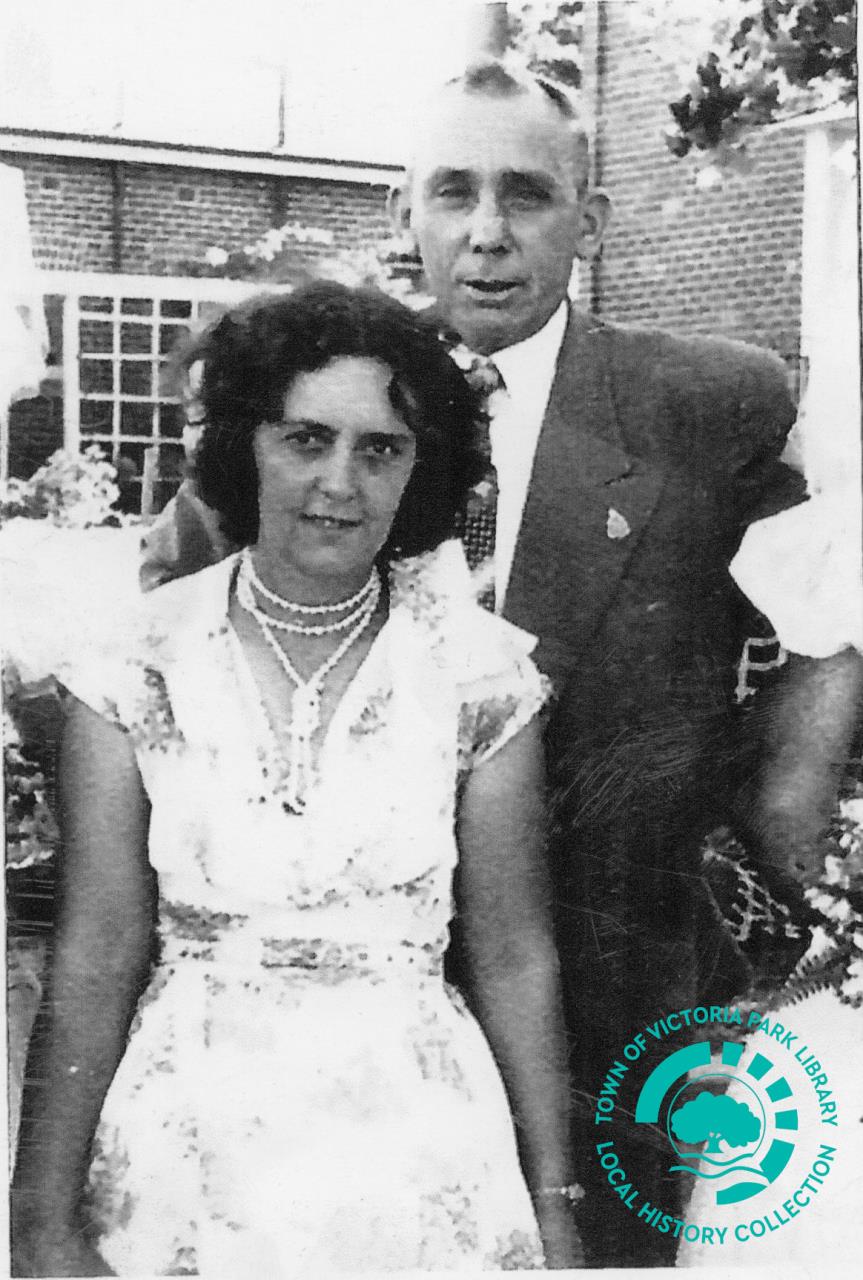
PH00479-08 Arthur and Gertrude Huggins at an unknown formal event.
Courtesy of the Huggins Family.
Life After the War
Upon his return to civilian life Arthur returned to his home at 31 Kent Street Victoria Park, where he and Gertrude extended their family by two girls, Faye and Carole. The family of seven were in July 1946 living at 2 Venus Street, Carlisle where they continued to live until at least 1953. Four more children were born here, Gloria, Ronald, Brian and Patricia, taking their family to nine children.
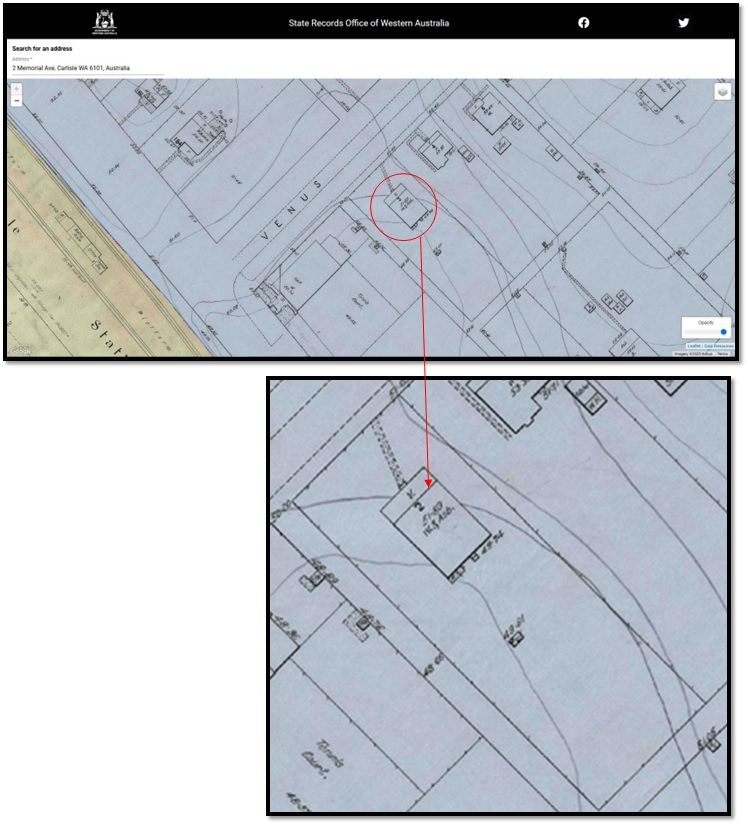
The old sewerage maps of Perth geo-referenced onto current aerial photography indicates where Arthur and Gertrude Huggins’ house used to stand, behind the Carlisle Memorial Hall at No. 2 Venus Street (now Memorial Avenue), Carlisle.
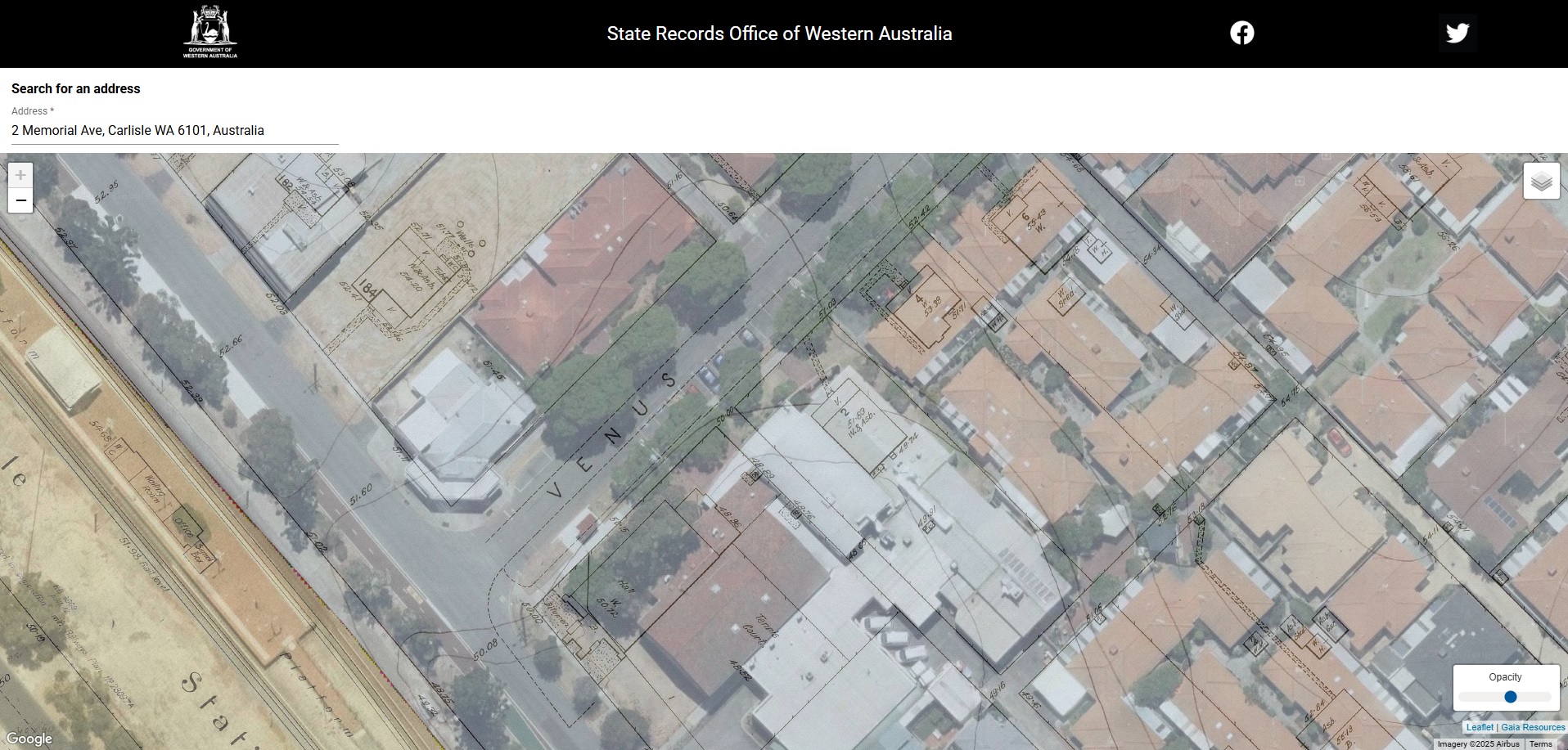
No. 2 Venus Street, (now Memorial Avenue) Carlisle as seen on RetroMaps with the opacity adjusted to show then and now. The Harold Hawthorne Community Centre takes up all of the former No. 2 Venus Street and the site of the old hall and tennis courts.
Courtesy of the State Records Office of Western Australia
Arthur continued to enjoy cricket and played for the Carlisle Cricket Club. The family home in Venus Street, now Memorial Avenue, Carlisle was directly behind the Carlisle Soldiers Memorial Hall (8) and is now the site of the Harold Hawthorne Community Centre. The Huggins family, living on the street at this time, were possibly witnesses to the planting of the street, on either side for its entire length, with jacaranda trees in July 1957. An ‘avenue of honour’ was thus created to remember the fallen sons of Carlisle. The name of Venus Street was officially changed to ‘Memorial Avenue’ on 31 January 1959.
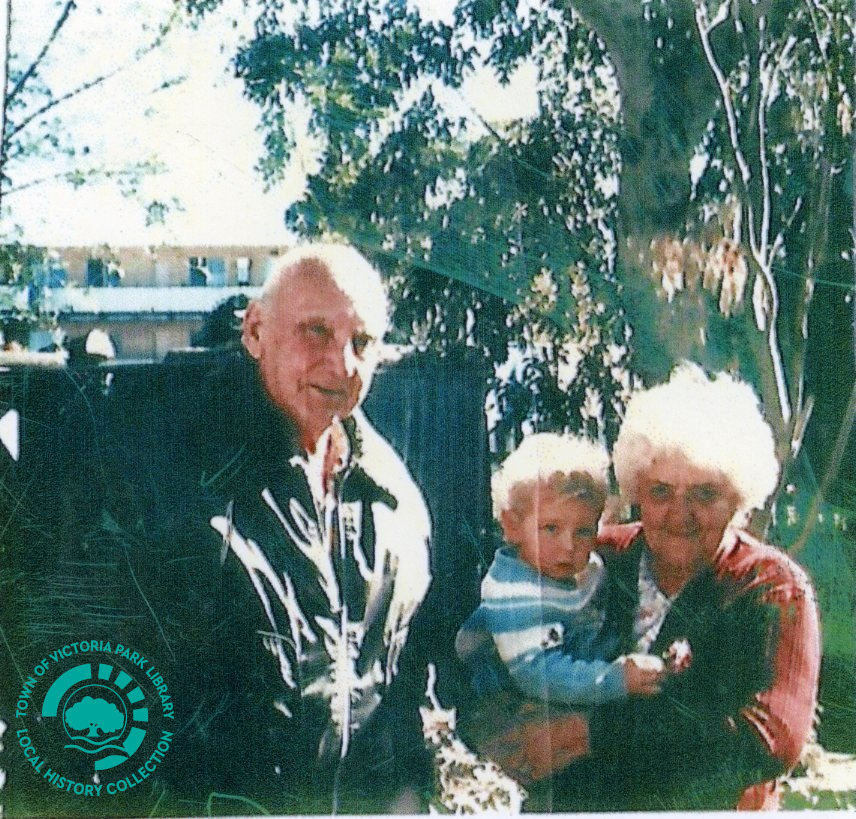
PH00479-09 Arthur and Gertrude Huggins with one of their grandsons, c. early-1980s. Courtesy of the Huggins Family.
Legacy
Like so many of his fellow returned servicemen, Arthur didn’t talk much about his experiences of war preferring instead to focus on his family and providing his wife and children with a happy life and childhood. Arthur is known to this day, especially by his many grandchildren, nieces and nephews, as a fun loving man with a great big warm smile. He is remembered for taking the time to listen to the little ones’ problems and concerns as if they were all grown up, making those beloved family members love him all the more. Each Sunday, lunch was a roast dinner at the Huggins’ house in Carlisle, and the whole family was invited, even those who crashed the night were treated to a breakfast of yummy leftovers, cooked by Arthur himself!
Perhaps all the tragedy and hardship seen, affirmed to Arthur and others like him, that the ‘innocence’ of the next generation, so far as it could be helped, should be protected above all costs to themselves. Whilst the stories of war weren’t passed down to his family by Arthur himself he gave instead the gift of hospitality and love to all who knew him. He was always ready with a smile, a laugh and his time.
Sometime between 1963 and 1968 the family moved to Bentley, and Arthur and Gertrude continued to enjoy their extended family. Arthur died in 1987, aged 77 and his beloved Gertrude survived him by 13 years, dying aged 86 years in June 2001.
Arthur’s name is listed on the cenotaph at the Victoria Park RSL on Fred Bell Parade, East Victoria Park.
Lest We Forget
Lance Corporal Arthur Henry Huggins (WX3184)

Postscript
Private Charles Drake, the fellow POW who self-sacrificingly and with great humility, gave his place in the prisoner exchange program to Arthur as a ‘man with a family’, returned to Australia in September 1944, and later married.
Family Tree
Edward HUGGINS
Born: 1878, Perth, WA to William HUGGINS and Margaret Jane MORTON
Married: Florence Louisa DIXON – 1902, Bunbury WA (Florence died: 13 May, 1959, Bentley, WA aged 74 years)
Died: 19 June, 1948, Victoria Park, WA, aged 69 years.
Children:
-
-
- Louisa Madge HUGGINS
- Born: 1902 Waterous Mill, WA
- Married: 1924 Perth, WA – Edward Bertram DILLON
- Died: 1975, Perth, WA
- Edward James Clarence HUGGINS
- Born: 1904 Greenbushes, WA
- Died: 1904 Greenbushes, WA aged 4 months
- Lily May HUGGINS
- Born: 1905 Lion Mill, WA
- Died: 1907 Perth, WA aged 15 months
- Arthur Henry HUGGINS
- Born: 24 July, 1910 Jarrahdale, WA
- Married: Gertrude NIELD - 17 March, 1935 Church of the Transfiguration, Leonard Street, Victoria Park, W
- Children:
- Margaret
- Shirley
- Edward Philip
- Faye Lorraine
- Carole Joyce
- Gloria Anne
- Ronald Arthur
- Brian
- Patricia Joan
- Died: 27 September, 1987, Bentley, WA
- Albert Philip HUGGINS
- Born: 1913 North Dandalup
- Married: 1933 Victoria Park, WA – Bessie SKEIN
- Died: 18 May, 1987, St. James, WA
- Sydney Alma HUGGINS
- Born: 1916 Perth, WA
- Died: 1916 Subiaco, WA aged 1 week
- Norma Florence HUGGINS
- Born: 1924 Subiaco, WA
- Married: 1944 Victoria Park, WA – Roy George KENT
References
(1) Australian War Memorial, ‘2/7th Australian Infantry Battalion’ [unit history], Australian War Memorial, Canberra, https://www.awm.gov.au/collection/U56050, re-accessed 1 October 2025.
(2) 1941 'AUSTRALIAN CASUALTIES FOR FOUR STATES.', The Sydney Morning Herald (NSW : 1842 - 1954), 20 June, p. 5. , viewed 01 Oct 2025, http://nla.gov.au/nla.news-article17758588
(3) Brown Ian, 2001, ‘Stalag 18’, [Online], originally viewed 20 Dec 2009, http://www.btinternet.com/~stalag18a/stalag.html,, viewed 1 Oct 2025, http://www.stalag18a.org/stalag.html
(4) 1941 'Captured In Crete', The Daily News (Perth, WA : 1882 - 1955), 30 September, p. 9. (FIRST EDITION), viewed 01 Oct 2025, http://nla.gov.au/nla.news-article78805707
(5) Allan, Les 2005, ‘The Repatriation of Wounded Prisoners’, in The National Ex-Prisoner of War Association [Newsletter], Winter 2005, accessed online 1 October 2025. https://www.prisonersofwarmuseum.com/the-national-association-of-ex-prisoners-of-war-newsletters/, [p. 19].
(6) 1943 'Out Of Germany', Sunday Times (Perth, WA : 1902 - 1954), 28 November, p. 6. , viewed 01 Oct 2025, http://nla.gov.au/nla.news-article59189383
(7) 1944 'P.O.W. GAVE PLACE TO HIS FRIEND', The Daily News (Perth, WA : 1882 - 1955), 3 February, p. 3. (CITY FINAL), viewed 01 Oct 2025, http://nla.gov.au/nla.news-article78797175
Bibliography
- 1933 'BROKE ALGAE FENCE', The Daily News (Perth, WA : 1882 - 1955), 2 March, p. 5. (HOME EDITION), viewed 22 Oct 2025, http://nla.gov.au/nla.news-article83412889
- 1933 'DAMAGE TO ALGAE FENCE.', The West Australian (Perth, WA : 1879 - 1954), 3 March, p. 12. , viewed 22 Oct 2025, http://nla.gov.au/nla.news-article32486945
- 1933 'DAMAGE TO ALGAE FENCE.', The Swan Leader (Victoria Park, WA : 1931 - 1937), 10 March, p. 1. , viewed 22 Oct 2025, http://nla.gov.au/nla.news-article257739185
- 1941 'AUSTRALIAN CASUALTIES FOR FOUR STATES.', The Sydney Morning Herald (NSW : 1842 - 1954), 20 June, p. 5. , viewed 01 Oct 2025, http://nla.gov.au/nla.news-article17758588
- 1941 'Captured In Crete', The Daily News (Perth, WA : 1882 - 1955), 30 September, p. 9. (FIRST EDITION), viewed 01 Oct 2025, http://nla.gov.au/nla.news-article78805707
- 1941 'Captured In Crete', The Daily News (Perth, WA : 1882 - 1955), 30 September, p. 16. (FIRST EDITION), viewed 22 Oct 2025, http://nla.gov.au/nla.news-article78805887
- 1943 'Out Of Germany', Sunday Times (Perth, WA : 1902 - 1954), 28 November, p. 6. , viewed 01 Oct 2025, http://nla.gov.au/nla.news-article59189383
- 1944 'P.O.W. GAVE PLACE TO HIS FRIEND', The Daily News (Perth, WA : 1882 - 1955), 3 February, p. 3. (CITY FINAL), viewed 01 Oct 2025, http://nla.gov.au/nla.news-article78797175
- 1944 'NAZIS CONVINCED THEY CAN'T WIN', The Daily News (Perth, WA : 1882 - 1955), 14 September, p. 5. (CITY FINAL), viewed 22 Oct 2025, http://nla.gov.au/nla.news-article78522314
- 1944 '"Aussies" Singing K.O. To Nazi P.O.W.'s!', Mirror (Perth, WA : 1921 - 1956), 16 September, p. 3. , viewed 22 Oct 2025, http://nla.gov.au/nla.news-article76014183
- 1944 'Prisoner Is Coming Home', The Daily News (Perth, WA : 1882 - 1955), 27 May, p. 14. (LATE SPORTS), viewed 22 Oct 2025, http://nla.gov.au/nla.news-article78392256
- 1947 'BETTORS CHARGED', The West Australian (Perth, WA : 1879 - 1954), 4 June, p. 14. (SECOND EDITION.), viewed 22 Oct 2025, http://nla.gov.au/nla.news-article46316163
- 1948 'PICNIC CRICKET', South Western Advertiser (Perth, WA : 1910 - 1954), 19 March, p. 3. , viewed 22 Oct 2025, http://nla.gov.au/nla.news-article148655581
- 1948 'TWO-UP PLAYERS FINED', The West Australian (Perth, WA : 1879 - 1954), 23 March, p. 17. , viewed 22 Oct 2025, http://nla.gov.au/nla.news-article46898337
- 1949 'BETTING FINES', The West Australian (Perth, WA : 1879 - 1954), 27 December, p. 11. , viewed 22 Oct 2025, http://nla.gov.au/nla.news-article47819878
- Allan, Les 2005, ‘The Repatriation of Wounded Prisoners’, in The National Ex-Prisoner of War Association [Newsletter], Winter 2005, accessed online 1 October 2025, https://www.prisonersofwarmuseum.com/the-national-association-of-ex-prisoners-of-war-newsletters/, [p.19].
- The Anglican Church Archives, ‘Victoria Park’, research paper, unknown date.
- Australian War Memorial, ‘Charles John Drake’, in Middle East – Recovered Prisoners of War Rolls, 1939-45 War, Australian Army, Casualty Section, 2nd Echelon, accessed online 6 October 2025, https://www.awm.gov.au/collection/R2817254.
- Australian War Memorial 2025, ‘Australian prisoners of war: Second World War – prisoners of Europe’, Australian War Memorial, accessed online 17 October 2025, https://www.awm.gov.au/articles/encyclopedia/pow/ww2.
- Australian War Memorial, ‘2/7th Australian Infantry Battalion’ [unit history], Australian War Memorial, Canberra, https://www.awm.gov.au/collection/U56050, re-accessed 1 October 2025.Brown Ian, 2001, ‘Stalag 18’, [Online], originally viewed 20 Dec 2009, http://www.btinternet.com/~stalag18a/stalag.html,, viewed 1 Oct 2025, http://www.stalag18a.org/stalag.html
- Moosburg Online 2022, ‘POW camp Stalag VII A’, accessed online, 1 Oct 2025, https://www.moosburg.org/info/stalag/indeng.html.
- National Archives of Australia : Australian Military Forces ; B883 : WX1131 : 6451761 ; DRAKE CHARLES JOHN : Service Number - WX1131 : Date of birth - 03 May 1919 : Place of birth - POPLAR ENGLAND : Place of enlistment - SUBIACO WA : Next of Kin - DRAKE C
- National Archives of Australia : Australian Imperial Force ; MT1486/1 ; HUGGINS/EDWARD : 9520996 ; Huggins, Edward; age 36; address – Perth.
- National Archives of Australia : Australian Military Forces ; B883 ; WX3184 ; 6454101 ; HUGGINS, ARTHUR HENRY : Service Number – WX3184 : Date of birth – 24 Jul 1910 : Place of birth – JARRAHDALE WA : Place of enlistment – PERTH WA : Next of Kin – HUGGINS GERTRUDE
- National Archives of Australia : Australian Military Forces ; B883 ; WX1801 ; 6462085 ; HUGGINS ALBERT PHILIP : Service Number - WX1801 : Date of birth - 28 Apr 1913 : Place of birth - NTH DANLUP WA : Place of enlistment - SUBIACO WA : Next of Kin - HUGGINS BESSIE
- Rutter, Fred 2023, ‘Arthur Henry Huggins – WX3814 - Service to Australia’, Forrestfield, WA.
- Virtual War Memorial Australia 2025, ‘HUGGINS, Arthur Henry’, Virtual War Memorial Australia, RSL, accessed online 1 Oct 2025, https://vwma.org.au/explore/people/ 1477562
- Western Australia. Department of Justice, Registry of Births Deaths and Marriages, accessed online multiple dates, https://www.wa.gov.au/organisation/department-of-justice/online-index-search-tool
- Western Australia. Metropolitan Cemeteries Board 2025, ‘Name Search’, accessed October 2025, https://mcbportal.powerappsportals.com/name-search/
- Western Australia. State Records Office of Western Australia 2025, ‘RetroMaps’, accessed online 1 Oct 2025, https://mapping.sro.wa.gov.au/#/
|
This article was written by guest historian Fred Rutter and Rosemary Ritorto, Local History Coordinator, Victoria Park Library.
It was first published in Victoria Park Dictionary of Biography, Town of Victoria Park Library, October 2025.
Arthur Henry HUGGINS was especially commemorated as the Local Focus Hero at the Town of Victoria Park’s Remembrance Day commemorations at Memorial Gardens, Albany Highway, Victoria Park, on 11 November 2025. The Town was honoured that over twenty descendants of Arthur, including his daughter Faye, were able to attend the commemoration.
You can pick up a copy of his special commemorative booklet from the Library and or download a copy to keep: Arthur's commemorative brochure 
A PDF copy of Arthur's entry into the VPDB is available here.
|